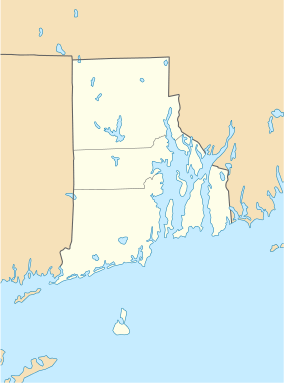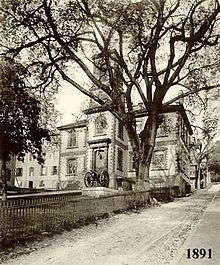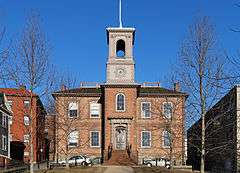Old State House (Providence, Rhode Island)
|
Sixth District Court House (Old State House) | |
|
Old State House in 2008 | |
  | |
| Location | 150 Benefit St., Providence, Rhode Island |
|---|---|
| Coordinates | 41°49′44″N 71°24′34″W / 41.82889°N 71.40944°WCoordinates: 41°49′44″N 71°24′34″W / 41.82889°N 71.40944°W |
| Built | 1762 |
| Architectural style | Georgian architecture |
| Part of | College Hill Historic District (#70000019) |
| NRHP Reference # | 70000092[1] |
| Significant dates | |
| Added to NRHP | April 28, 1970 |
| Designated NHLDCP | November 10, 1970 |
The Old State House on College Hill in Providence, Rhode Island, known also as Providence Sixth District Court House, Providence Colony House, Providence County House, or Rhode Island State House is located on 150 Benefit Street. It is a brick Georgian-style building completed largely in 1762. It was used as the meeting place for the colonial and state legislatures for 149 years.
History
From colonial times to the mid-19th century, the Rhode Island General Assembly rotated meetings between the state's five county court houses, and five of these former Rhode Island state houses survive today. In 1760 The General Assembly built the Old State House to replace an earlier wooden courthouse built 1730 on Meeting Street. It was largely finished by 1762 with some details being completed by 1771. Many of the Georgian architecture details were borrowed from the larger and more ornate Newport Colony House. Before 19th century alterations to the Providence State House, the two buildings resembled one another greatly. After 1853 the state legislature ceased meeting at Kent, Washington and Bristol county courthouses, but continued to alternate its sessions between here and the Newport State House in Newport into the early 20th century.
The building was extensively renovated and dramatically altered several times in the 19th century. The first of these occurred in 1835-36 and 1840, and consisted of rearrangement of large portions of the interior.[2] It was again altered in 1850, when Thomas A. Tefft of Tallman & Bucklin added the large tower facing Main Street, and a reorganization of nearly the entire interior. In 1867 James C. Bucklin designed an addition on Benefit Street that nearly doubled the size of the building. Both of these additions were sympathetic to the building's original design.[3] The building was refurbished in 1877-83, to designs by Stone & Carpenter.[2]
The building served as the legislature's meeting place until 1901, when the new Rhode Island State House began being occupied. The building was completely finished in 1904, and it was decided to use the old building as a courthouse. Major internal alterations by Banning & Thornton were completed in 1906, and the building re-opened as the Sixth District Courthouse.[4]
At the Old State House on May 4, 1776, the General Assembly declared its independence renouncing its allegiance to the British crown, and the date is now celebrated as Rhode Island Independence Day. Debates about slavery occurred in the building in the late 18th century. George Washington visited the building in 1781 and 1790. By 1901 the new Rhode Island State House was occupied on Smith Hill and the legislature vacated the Old State House.

The Old State House was used as a Court House until 1975 and was listed in the National Register of Historic Places in 1970 and as part of the College Hill Historic Landmark District in 1971.
The building is now home to the Rhode Island Historical Preservation Commission.
Layout
A open space hall for public meeting was located on the main floor and later became a courtroom.[5]
On the second floor was the House of Representatives and Senate chambers. Additional space was create for the Governor's and Secretary of State's offices.[5]
See also
References
- ↑ National Park Service (2007-01-23). "National Register Information System". National Register of Historic Places. National Park Service.
- 1 2 The State Houses of Rhode Island: An Architectural and Historical Legacy. 1988.
- ↑ Woodward, Wm. McKenzie. Providence: A Citywide Survey of Historic Resources. 1986.
- ↑ Jordy, William H. Buildings of Rhode Island. 2004.
- 1 2 "Rhode Island Historical Preservation & Heritage Commission: About the Commission". ri.gov. Retrieved 10 February 2015.
External links
Conley, Patrick T.; Jones, Robert B.; Woodward, William Ray (1988). The State houses of Rhode Island: an architectural and historical legacy. Providence, R. I.: Rhode Island Historical Society and Rhode Island Historical Preservation Commission. ISBN 0-932840-04-3.
